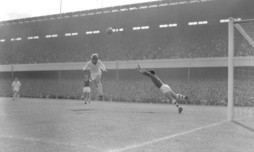
Tiger Ian wore his SNP badge with pride until it nearly poisoned him.
Allan McGregor is the latest Scot to head for the English Premier League. The former Rangers goalie will be Hull City’s last line of defence on their return to the top flight in the coming season.
While there’s no doubt about his ability, McGregor will have to go some to make the impact of Hull’s most famous Scottish goalkeeper.
Ian McKechnie was the sort of colourful character rarely seen in the modern game. Aside from a short spell in America, he spent his entire career in England. He remained fiercely proud of his roots and was always looking to fly the flag for Scotland.
But his manager put a stop to that when he feared Ian was taking things a bit too far.
He recalls: “In 1969 I started wearing a metal SNP badge on my goalkeeper’s top. My young brother had sent it down from Scotland and persuaded me to wear it.
“It was just a bit of bravado, flying the flag amongst the English guys who used to give me a bit of stick. But it probably wasn’t the best idea for someone who was throwing them round a goalmouth.
“I got stabbed twice by the pin on the badge and it got dented after being hit by a fierce shot. Our manager, Cliff Britton, eventually had words with me about it.
“He reckoned there was a danger I’d get blood poisoning if I kept getting stabbed and banned me from wearing it.”
A badge ban wasn’t the only weird incident in Ian’s career.
He was the man regularly pelted with oranges by the home fans!
He recalls: “That started when I was seen buying an orange after training by a young supporter.
“At the next match a couple of oranges were thrown in my direction from the crowd. I picked them up and thought little about it.
“But it became a sort of cult thing and as the weeks went by, more and more oranges were chucked in my direction. The groundsman and I would bring out bags to take them away.”
Things went a bit sour, however, when Hull were playing away at Sheffield United. A young fan lobbed an orange in the keeper’s direction and was promptly arrested.
Ian goes on: “I told a policeman they did this all the time in Hull and it was only a bit of fun.
“He said to me ‘they might do it in Hull but they’re not bloody doing it in Sheffield’.”
Hull manager Terry Neill had to send a letter defending the supporter when the case came to court.
Ian’s route to a career in goal was far from conventional.
Signed by Arsenal as a left-winger in 1958 after playing amateur football in Glasgow, he was converted into a keeper after pulling on the gloves in a practice match. He played 25 top-team games for the Gunners, including their first two European ties.
With Hull he became the first keeper to save and miss a spot-kick in a penalty shoot-out. He saved Denis Law’s kick in a Watney Cup semi-final against Manchester United, then sent his effort over the bar.
Now 71, he’s retired and lives in North Humberside.

Enjoy the convenience of having The Sunday Post delivered as a digital ePaper straight to your smartphone, tablet or computer.
Subscribe for only £5.49 a month and enjoy all the benefits of the printed paper as a digital replica.
Subscribe